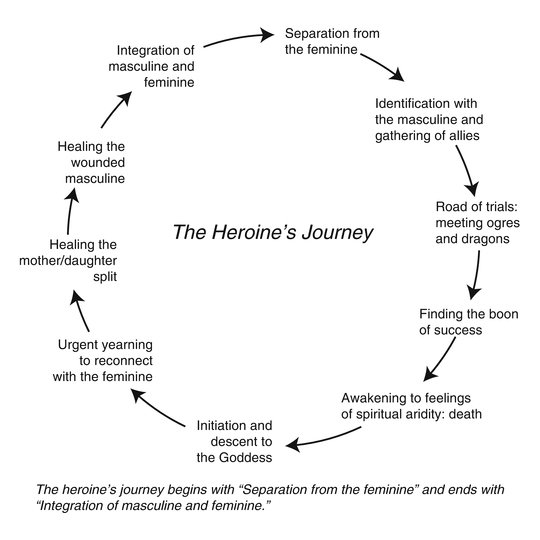
Many people are familiar with Joseph Campbell, world religion and mythology professor who outlined the infamous Hero’s Journey- the psychological evolution of man. According to Campbell, The Hero’s Journey is the building block of all myth and the foundation for many notable movies and stories of our time. For instance, George Lucas credits Campbell as a direct inspiration for Star Wars, and author Dan Brown echoes this sentiment as it pertains to his novels. Interestingly enough however, Campbell asserted that The Hero’s Journey did not apply to women, whom he believed possess a different role- to nurture.
Maureen Murdock, acclaimed psychoanalyst, firmly disagrees with Campbell and offers up a feminine alternative. Entitled The Heroine’s Journey, Murdock has provided women with a reference point for understanding the process of their own inner alchemy. I have found it to be an indispensable resource, bringing profound clarity in my efforts to make sense of my personal individuation process. Those who are committed to inner work are not given an instruction manual- oftentimes it can feel like fumbling around in the dark. Campbell and Murdock’s work however, comes close. I hope that her clear structure and steps bring you illumination as well.

Step 1: Separation from the Feminine
The Heroine’s Journey begins with the psychological and physical separation from both the personal mother and the mother archetype. As a result, the young woman often separates (perhaps unconsciously) from her own feminine nature. Especially if she experienced her mother as expressing the shadow archetype- the Devouring Mother. The qualities of the shadow archetype include- helplessness, manipulation, wrath, submission, rejection and self-loathing.
Separating from one’s mother is especially challenging for girls because they must separate from themselves from the one most like them. Adding to the complexity is the push-pull between wanting mother’s love and approval and desiring greater autonomy and freedom than mother ever experienced.
Until recently, the women’s role was in the home- raising children and ensuring the household ran smoothly. A woman’s position as homemaker and mother was not up for debate, it was their lot in life. As a result, many girls renounce their mother’s path. They decide to walk in their father’s footsteps instead, determined to forge their own identity and compete for a new place in society.
If a girl experiences her mother as rejecting, she will likely perceive her father as a hero with all the trappings of status and sovereignty. She will model herself after him, look for his validation and sometimes even seek to be him. Unfortunately, in the process young women often cast off the qualities of the positive feminine; traits such as nurturing, cultivating relationships and emotional intimacy.

Modeling the Power Paradigm
The reality is that we live in a patriarchal culture that would benefit from balance. Women have grown up learning about the fantastic feats of (mostly) men in history books and being exposed to warped images of the female body by the media and companies hoping to rake in the big bucks. Consequently, women frequently feel alienated from their bodies and feminine nature early on, internalizing the inhuman desire for perfection and power over oneself (and others).
More often than not, women seek power and authority by acting like men or vying for male approval. This was how they were taught to ‘get ahead’ in the masculine paradigm. Developing the qualities of the positive father archetype such as discipline, decisiveness, logic and purpose can certainly aid women in the quest for success and societal recognition. However, it becomes problematic when a woman believes that she ceases to exist unless her image is reflected back to her in the mirror of male definition and attention. As Maureen Murdock astutely states, “The young woman starts to see the male world as adult and she becomes identified with the internal masculine voice that tells her that productivity, achievement and success determines her worth. She has the focus and determination to achieve her goals and often accepts responsibility for more than she can comfortably handle.”
The young woman, in separating from the feminine, frequently expects nothing less than perfection from herself and has little patience for her own vulnerability. In her desperate attempts to not be like a woman, she essentially becomes like a man- thinking like him and putting in even longer hours at work than he does. According to the values of the goal-driven, power-oriented culture at large she is a success! Even if she abstains from entering the workforce, her inner voice is often masculine, critical and perfectionistic.
Sources:
Heroine’s Journey Infographic: “Articles: The Heroine’s Journey.” Maureen Murdock, 7 June 2016, maureenmurdock.com/articles/articles-the-heroines-journey/.
Murdock, Maureen. Heroine’s Journey Workbook : A Map for Every Woman ‘S Quest. S.L., Shambhala, 2020.
Welsh, Matt. “Joseph Campbell, Star Wars and the Hero’s Journey.” Spiritual Media Blog, 19 Feb. 2018. www.spiritualmediablog.com/2018/02/19/joseph-campbell-star-wars-and-the-heros-journey/. Accessed 15 June 2022.





